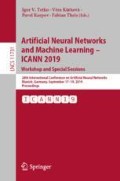Abstract
Reservoir computing is a bio-inspired computing paradigm for processing time-dependent signals. Its photonic implementations have received much interest recently, and have been successfully applied to speech recognition and time-series forecasting. However, few works have been devoted to the more challenging computer vision tasks. In this work, we use a large-scale photonic reservoir computer for classification of handwritten digits from the MNIST database. We investigate and compare different feature extraction techniques (such as zoning, Gabor filters, and HOG) and report classification errors of 1% experimentally and \(0.8\%\) in numerical simulations.
Supported by AFOSR (grants No. FA-9550-15-1-0279 and FA-9550-17-1-0072), Région Grand-Est, and the Volkswagen Foundation via the NeuroQNet.
Access this chapter
Tax calculation will be finalised at checkout
Purchases are for personal use only
References
Bahi, H.E., Mahani, Z., Zatni, A., Saoud, S.: A robust system for printed and handwritten character recognition of images obtained by camera phone. Technical report (2015). http://www.wseas.org/multimedia/journals/signal/2015/a045714-403.pdf
Bengio, Y., Courville, A., Vincent, P.: Representation learning: a review and new perspectives. IEEE Trans. Pattern Anal. Mach. Intell. 35(8), 1798–1828 (2013). https://doi.org/10.1109/tpami.2013.50
Bueno, J., et al.: Reinforcement learning in a large-scale photonic recurrent neural network. Optica 5(6), 756 (2018). https://doi.org/10.1364/optica.5.000756
Cortes, C., Vapnik, V.: Support-vector networks. Mach. Learn. 20(3), 273–297 (1995). https://doi.org/10.1007/bf00994018
Dalal, N., Triggs, B.: Histograms of oriented gradients for human detection. In: 2005 IEEE Computer Society Conference on Computer Vision and Pattern Recognition (CVPR). IEEE (2005). https://doi.org/10.1109/cvpr.2005.177
Daugman, J.G.: Two-dimensional spectral analysis of cortical receptive field profiles. Vis. Res. 20(10), 847–856 (1980). https://doi.org/10.1016/0042-6989(80)90065-6
Hagerstrom, A.M., Murphy, T.E., Roy, R., Hövel, P., Omelchenko, I., Schöll, E.: Experimental observation of chimeras in coupled-map lattices. Nat. Phys. 8(9), 658–661 (2012). https://doi.org/10.1038/nphys2372
Hussain, A.B.S., Toussaint, G.T., Donaldson, R.W.: Results obtained using a simple character recognition procedure on Munson’s handprinted data. IEEE Trans. Comput. C–21(2), 201–205 (1972). https://doi.org/10.1109/tc.1972.5008927
Jaeger, H.: Harnessing nonlinearity: predicting chaotic systems and saving energy in wireless communication. Science 304(5667), 78–80 (2004). https://doi.org/10.1126/science.1091277
LeCun, Y., Bengio, Y., Hinton, G.: Deep learning. Nature 521(7553), 436–444 (2015). https://doi.org/10.1038/nature14539
Maass, W., Natschläger, T., Markram, H.: Real-time computing without stable states: a new framework for neural computation based on perturbations. Neural Comput. 14(11), 2531–2560 (2002). https://doi.org/10.1162/089976602760407955
Quinlan, J.R.: Induction of decision trees. Mach. Learn. 1(1), 81–106 (1986). https://doi.org/10.1007/bf00116251
der Sande, G.V., Brunner, D., Soriano, M.C.: Advances in photonic reservoir computing. Nanophotonics 6(3) (2017). https://doi.org/10.1515/nanoph-2016-0132
Wan, L., Zeiler, M., Zhang, S., Cun, Y.L., Fergus, R.: Regularization of neural networks using dropconnect. In: Dasgupta, S., McAllester, D. (eds.) Proceedings of the 30th International Conference on Machine Learning. Proceedings of Machine Learning Research, vol. 28, pp. 1058–1066. PMLR, Atlanta, Georgia, USA, 17–19 June 2013 (2013)
Author information
Authors and Affiliations
Corresponding author
Editor information
Editors and Affiliations
Rights and permissions
Copyright information
© 2019 Springer Nature Switzerland AG
About this paper
Cite this paper
Antonik, P., Marsal, N., Brunner, D., Rontani, D. (2019). Comparison of Feature Extraction Techniques for Handwritten Digit Recognition with a Photonic Reservoir Computer. In: Tetko, I., Kůrková, V., Karpov, P., Theis, F. (eds) Artificial Neural Networks and Machine Learning – ICANN 2019: Workshop and Special Sessions. ICANN 2019. Lecture Notes in Computer Science(), vol 11731. Springer, Cham. https://doi.org/10.1007/978-3-030-30493-5_19
Download citation
DOI: https://doi.org/10.1007/978-3-030-30493-5_19
Published:
Publisher Name: Springer, Cham
Print ISBN: 978-3-030-30492-8
Online ISBN: 978-3-030-30493-5
eBook Packages: Computer ScienceComputer Science (R0)

